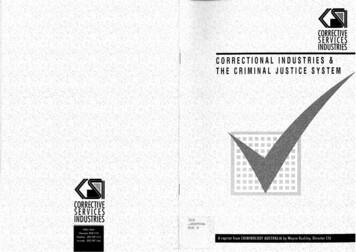
Transcription
--,.:' ·. -. ·.·. ·.' :. C0 RRECT1'0 NAl I NDUSTRI ES &:THE. CAl Ml NA1···JUSJI CE·.· ·SY.Sl·EM··,.-.'' :-·:' :.·,;. :.· . ·'··'.i: : .·. -, ·.··. ,·-., .36!::1"6 '\09'?44fi:UC 4Areprint from CRIMINIDILQGY AI!ISTRALIA by WayneRuckle ,,., -Director CSI
365 6509944RUC 4CorrectionalFi uck 1 E '/ lJJayrH2Cor·rec ional industriesand ttle c:riminalJ.\:f9LJ.f'\DF'·Al-'1-:tDATE DUEIndustries-and theCriminalJusticeSystemby Wayne RuckleyN.S.W. DEpt OF CORRECTIVE SERVICESLHiRAFIYPub/icatiou Ma)' !994.New South Ulrlles Corrective Seroices lHdustriesHolker Street, P.O. Box 6066Silverwater NSW Australia 2141Tel: (02) 289 5555 Fax: (02) 289 5566
Correctionaland the'CriminalJusticeSystemOver a number of years, various papers have been published about inmate work. In most eases they havefocused upon the dynamies of Correetional Industryprograms in their relevance to inmate development andCorrectionalmanagement.It is unfortunate; that rarelvcin embraeing this important subject, has the broaderrole and importance of work to the individual and tosoeiety been embraced. JI\\'as parlicularly.laken hy a recent edition .of !he lelevisi.onprogram "Four Corners·· which profiled thr humanlifecycleas . birth . school . \\'ork . death. Whilst this mightprofilr our life eydr in a ruther stark way. it does nevertheless focus upon the dinwnsion of\\'ork npon our lives. r lwlieve itis unforlunalr that the Au: ltralian culture tends to underscoreand undrrralue the role work plays in satisf)'ing our needs andour drvf'iopmcnt. The ·'Four Corners'' program continued:"Each and everyprisoner inthe systemis given theobligation andopportunityto do real andmeaningful,wor.k"From birth to death. it's \\'ork thai shapes us. II is a simplet'qualion. Work rquals ineomc, opportunity. seeurity. It gives uspurpose. With \\'ork 1\'C belong. \Vorl in this society is identity."II is ll'ilh the realisation of the role and Yalne of work to !he individual and to soddy in mind that the eurrrn! program ofCorrceliona! Indu:-;try expansion nnd commercialisation in :New South\Vales e\'oln d. The former Premier of 'iSW. the llon. 'iic·i Greiner, \IP on 27th April, 1989committed the new Governmentlo this program in quite a profound \I'll)'."One of the dear cut goals in myadministration is to ensure thatthe long IC'nn rundown in Prisonlndnslrics is n versed and !halwithin the firs! term ofGoYemmcnl (if at all possible,) eaeh andevery prisoner in the system isgiven the obligation and opportunity to do real and meaningful ll'ork.''On tlw sanw day. the former'linisler for Correelive Services.the llon. \lidwel Yahsley IPprofiled the Governments philosophical commifmenl in a verydircel manner:"ll is not work lill' the sake ofPage 2CSIIumates ill NSTV CorrettioNalfllSfitutions pnrtin'pare ina u ideral/ge of ind!l 'l!)', indudiflghortia!lture (opposite) upholsrn:va11d meffll mgitJfl'l'illg.work, so that the Government can indulge in some kind of ehest beating exerciseand say that we have gclt. them all working now and they wert not working before. IIis very deliberately a program directed at rehabilitation, so as t.lmt gTPat goal can heachieved that it is referred to by so many observers and experts in the fleld of penology. That is making prisoners eome out of the system better people Uum when th8y\\'ent in, ready to resume a law abiding life ll'ilh skills that they did not ha\'e \\'henfirst they entered the prison system."C!early the tide had tumed towards the imperali\'e of having inmates engaged in meru.lingful program aelivily. What was important however, wasthat the policy eommilment of tlw ineoming Govemment was not merelypoliticalrhetorie. II was hacked up by a level of structural and organisational commitment previously unknown to Corrcclionnl Industry programs. The'hand brake' which for so long had hampered !he role of Correctional Industries tofulfil their potential and to serve the community had !wen released. This included: Aelear policy commitment to provide an optimised implementation of the so rulledeompcting dilemmas ofCorreef.ional Industry operation. I refer to inmate drvclop ment, Correetional Centre management and eeonomk pcrfonnanee expcetalions.e The progressive commcreialisation of Gorreetive Serviecs Industries (CSI) worh;programs. to ennhlc those programs to rcf1ret and maintain real world 'worl cnvi ronments'. This also meshed with Clthaneed cxpcetations over the general performante of Govcmment Trading Enterprises.N.S.W. DEPT. OF CORRECTIVE SERVICESLIBRARYCSIPage 3
The ability ofCorrcdive Serviees Industries, oftrm against host.ilP !'( action fromsonw hn iness groups, to sottre( and negotiate market opportunities to generatework for inmalrs.0\'erduc strnel.uralreform toetw.ble CSI to operate on a eommercialised basis to fncilitatelongterm business planning; to7generate ineomc to self.-tlnanee6program derclopmenl; and tore5souree capital development ;:tndreplacement initiatives.9INMATE EMPLOYMENTFignrr 1.97651986/87"In this period, mm·e commercial basedinmate work positions have been created infive years, than existed after 200 years ofCorrections in New South Wales."G. ) I has rapped into the II'SO!f!'Ces of NS W TA FE 1i1 order to give itmiateJ· the dJa!ltl' toleam reod.· J'ki!!s 1111d gflliJaanditer/ qualificatio!ls that &w'/1 mha11ce t/1tir dJII!lC6 olpost-rdmse employmmt. Small offu:t pliJJfliJg at the Ptlt:Hm Young Ojfewlers' .Conntio11al Cmfll' (be/of ;') a11d the Hard Rod: Balr·n:)'a! Lo11g Bay (oppoJ·ite pagl') are/reo exampk. : of the VI FE jJI'Ogra!!l J· stVCfSS.What has occurred in New South\'hies O\'Cl' 1-he last 5 years interms of Correctional Industn''.expansion and -eonnnerdalisation is nnpreccdcntrd. This lwshad a profound and visual impaet upon CorrecUonal Centrepopulations. Throughout the NS\VCorrectional system) new industry facilities have been opened; existing t wilities havebeen revitalised and extended and faeilil.iespreviously dosed reopened. No longer are C:orreetional Centres typified by groups of inmahY;;laying idle in yards with all of the inherent destructive intlmmees of human boredom. ln sueha situation little hope existed tor either the inmate or the community.Creating He\r work positions how('VCI', hasonly reprrsented a small part oft.lw overallCSIJConunereialisation is really about rcpli(·ating eommunity based work environments. This is fundamentallo provideinmates with dr'vclopmcnt opportunitiesto enhance their opportunity to underslnnd andvalue !lw work rt.hie and to gain and retain employment upon release. II is ahoullinldng edutation and work in Ihe wm:! :plaec: of establishingregular worldng hours of atlendanee; of csiHblishing produetivil.y and quality assurance targets: andof having a eustomcr focus.Having a eustomer foeus rreognises thai withouteustomers to generate sales, Correetiona[ Indimtries programs do not exist. In NSW, as with allCorrectional Industry programs, this has providmlone of our greatest elmllenges. It is just ten yearsago I hal the central marketing strategy for CSIrevolved around providing 'eheap produets'. On-Wmt will be found is a large pal"! ofhe inmate population engaged in a}ala nee of education. vocational declopmcnt and worl\ program adivity (sec Figure 1). This is facilitated through apo itive and produelin rapport between stafTandinmates which in turn has had n positivrnnd overwhelming influence over the stability ofthc t\SWCorreetional system. The structmal on !comes ofthis progrnm of Corr('efional IndtJSI.ry rcvi!alisat.ion have been impressive hy anyynnlsticlc An additiona12.l22 inmateworl positions hare been ercated representingnn inerea:.;e of 70%.fmportantly 1,48\J of these posit ions. an intn'ase of 125%, have been erealed withinCS[ commereial based business units. [nthis period more eommcreial based inmatework pot- it ions hnvc been ereatcd in5 yt'1l!'sthan existed afte.r 200 yPars of Correctionsin New Sonth Wales. This expansion has ofeourse lnken plaee in an era where the NRWCorredional Centre population has significantly inereased. Nevertlwlrss. inmatewol"i positions ll"ililin :\8\Y arc provided to80% ofthc Correetional C:Pnlrc population.Page4lprogTam ofrevitalisalion. Greatest tlftention lwsbern to cnsHre that. the po iit.ions r:reated are partof a work cnvirnnnwnl ·whieh rcfleets tlw rigours,diseiplines and satisfadion of a eommnnityworkplace. This is eommoreialisat.ion. It rrpresents the most misunderstood el1mwnt of Correctional Industry endeavour. There: unfortunate})(exists a common. hut false view that commercialisation simply reprC'sen!s a hell-bent desire toaehieve 'profit'. Nothing could he further fromthe truth.''Commercialisationis really aboutreplicatingcommunity basedwork environments."time deliveries, l{Uality produds and seniees andeuslomer snrviee largely did not exist.Thus grca.t attention has bc.en given tothe transformation of CSI ton professionaL and respected eommercialorganisation. This has incorporateda :;trong eommilment to husinPss planning andof'atlopting a nwrlwlingstralegywhith reeogni:wsthe eonslrainls and lim ita !ions of a Gorreetionalset! ing and of our \vtH'Id(H\'{!. We have developedand implemented a 'Customer Serriec Guaranu e' whieh is rcinforeed hy an enligh!J,ned customer Sf'niee program.We are both delighted and encouraged h)· themany t:ustonwr testimonials W(' no\r rl'cPire. Theyad as an inspiration and eneonragement to ho!:h staff andinmates. Our diverse eustomerbase, comprising private andpnhlie seetor eompanies willprovide record :-;ales of S 15min the current finaneial yearan increase of 80%. Theaehievement. of this sales development has not been without. representations from someseetions of the buBiness commtlnity about the legitimaey ofCorrectional Industries looperate within the marketplace.Notwithstanding that CSI iscommitted to adopling a sensitive and restrained presenerwiU in the marketplace, emnmunity coneerns unfortunatelyand predielahly I'Ppresent agetleral phenometla ofCorreetional Industry operation. II isho,rcver important to nole !hatCSJ has enjoyed a good rapportwith the Trade Cnion movement. Indeed t.he Seerelary, ofthe NSW TradPs nnd LaborCSIPage 5
Council, Mr. Michael JEasson carried out a far reaching review ofCSI operations during 1992. Comments made in the review report bear mention:''The concept of Corrective Services Industries and the path it iscurrently taking is in the broad sense to be congratulated andpromoted. It is certainly something which I believe should besupported and encourag·ed. To this end, it is important that C:SIcontinue to operate in the market at large and does not simplyrely, as has been the case some yf?ars before, on public sector eontracts. rrhis enables diversification) skills enhancement and greaterindustry significance for the skills taught and goods produeed.\\11ilst there \\'ill be successes as well as losses, it is nonethelessimportant to continue to focus on and commit resources to theprocess of rehabilitation. Corrective Services Industries has avital role to play in this process. '!'here is a good story to tell aboutthe work C:SI has done to date in the rehabilitation and training ofprisoners.'''.The diversity of C:SI functional commercial endeavoursreflects our commitment to operating sensitively andsensibly within the marketplace. We are fortunate tohave in place the Corrective Senices fndustries Consultative Council. rrhis Council, which comprises representativesof the Chamber of Manufacturers, the Metal Trades IndustriesAssociation, the Labor Council and a Community Representative,monitors the development and operation of C:SI to ensure otherbusinesses are not unreasonably impacted upon. A primary influence npon onr achievements has been the development of privatesector involvement in the management and operation of Correclional Industries. From complete management and operation, including provision of resource requirements- to more diluted formsof involvement. The private sector has been instrumental in sh0\1'ing what is possible and in facilitating the cultural change so necessary to achieve our contemporary policy objectires.Whilst the primary focus is not towards profit our commercialendeavours, including· upgraded pricing of our produets and serviees, have provided a start.ling and positive transformation. } )·oma chronic. loss maker in the 1980)s of around 1.5m per year to aposit.ivc contribution level of 2.5m in 1992/93 (see Figure 2).This has sceured the financial integrity and strategic direction ofC:SI. C:SI is providing large numbers of inmates with the opportunity to develop skills and habits that are of direct benefit to theiraeceplance of work and to their opportunity to gain and retainemployment upon release. With this iu mind the primary focus ofCSI programs is developing the work ethic and exposing inmatesto the responsibilities, satisfaction and rewards of real work.'Wdo not hold umeal expectations about our ability toink technical skill training with direct eommunityl'ork plaecment. In large part this evolves from our·estriel.cd market. aceess and eommitment to not unreasonably impact upon other businesses. ll also refleels the implications of a Correctional selting upon the realistic dimension ofour technical endeavours. This commitment is illustrated by thediversity of C:SI functional endeavours (see Fignre 3.) A manufacturer of metal and furniture products; an operator of a Dairy to aSawmill; a provider of re-upholstery services to a major texlileproduct supplier; provision of skilled seniees to a raugc of agricultural services; printed produels and electronics. C:SI work programs.whi st primarily catering for !hose inmates with educationalPage 6CSIand work skill deJleiencies, alsocater for !.hose inmates who possess sound to superior educational and work capabilities. rn)these inmates C:SI offers aunique range of opportunities toensure their creative talents canbe utilised in a constructive anduseful manne
'iic·i Greiner, \IP on 27th April, 1989 committed the new Government lo this program in quite a pro found \I'll)'. "One of the dear cut goals in my administration is to ensure that the long IC'nn rundown in Prison lndnslrics is n versed and !hal within the firs! term ofGoYem mcnl (if at all possible,) eaeh and every prisoner in the system is given the obligation and oppor tunity to .











